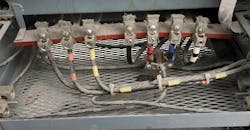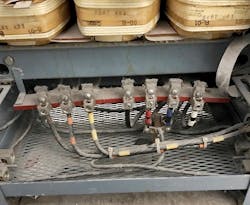AWECA alumni recently contacted me with a dilemma. His company was performing a tenant improvement (TI) project at a strip mall when one of the construction workers received an electric shock. However, it was unclear what the worker was doing at the time he received the shock, which obviously made it difficult for the team to locate the source of the voltage. This article will take a closer look at the situation and how it was resolved. Note: Some details have been changed to protect the identities of the parties involved.
To help solve the mystery, the crew decided to take some voltage measurements at the transformer that was feeding a panel in the TI space. The existing setup was a typical electrical installation — it consisted of a 3-phase, 30kVA transformer with a 480V delta primary, as well as a 208-120V wye secondary feeding a 200A panel. All the primary voltages appeared to be good, reading 277V from phase-to-ground and 480V phase-to-phase. However, when the secondary voltages were read, they proved suspect. Looking at the transformer, we can note that the primary conductors are on the left (brown, orange, yellow), and the secondary conductors are on the right (black, red, blue, white).
- A phase (black) to neutral = 120V
- B phase (red) to neutral = 120V
- C phase (blue) to neutral = 120V
- A phase (black) to ground = 208V
- B phase (red) to ground = 0V
- C phase (blue) to ground = 208V
- Neutral to ground = 120V
Based on the voltage readings and the Photo, can you identify the problem?
If you look closely, you can see there is a ground rod driven at the transformer, and there is no system bonding jumper (SBJ). Grounding and bonding are like a safety net — sometimes you don’t think about it until something goes wrong.
According to the secondary voltage reading, there is definitely something wrong. It would appear that there is a ground fault on Phase B, and — without an SBJ — the circuit with the ground fault cannot trip the circuit breaker and clear the fault.
What about the ground rod? The electrical current does not want to go to ground — it wants to return to the source. The SBJ connects the metal case of the transformer to the neutral on the transformer (making it the grounded conductor). Without it, the current cannot “get home.” This configuration also energizes all of the metallic parts.
After a couple of hours spent troubleshooting, the ground fault was pinpointed, and the transformer was properly bonded. Everything should be safe now — or is it? I mentioned something earlier that could potentially also be a problem.
The transformer is feeding a 200A panel. However, the transformer is severely undersized. A 3-phase, 30kVA transformer with a secondary voltage of 208V has a full load current (FLC) of 83A [30,000VA ÷ 208V × 1.73]. If the panel is loaded up, the transformer could overload and possibly burn up, posing several safety hazards.
Slemp has more than 20 years of experience working in the electrical industry. He has been an instructor for the Western Electrical Contractors Association (WECA) since 2001, primarily teaching second-year apprenticeship classes full-time. He also manages the WECA lab facility in Rancho Cordova, Calif., writes and develops apprenticeship and continuing education curriculum, and teaches continuing education classes. In 2006, he was presented with the Instructor of the Year award for his “commitment to the trade, creativity, patience, and love of teaching.” He can be reached at [email protected].
About the Author
Jimmie Slemp
Instructor
Slemp has more than 20 years of experience working in the electrical industry. He has been an instructor for the Western Electrical Contractors Association (WECA) since 2001, primarily teaching second year apprenticeship classes full-time. He also manages the WECA lab facility in Rancho Cordova, Calif., writes and develops apprenticeship and continuing education curriculum, and teaches continuing education classes. In 2006, he was presented with the Instructor of the Year award for his "commitment to the trade, creativity, patience, and love of teaching." He can be reached at [email protected].

